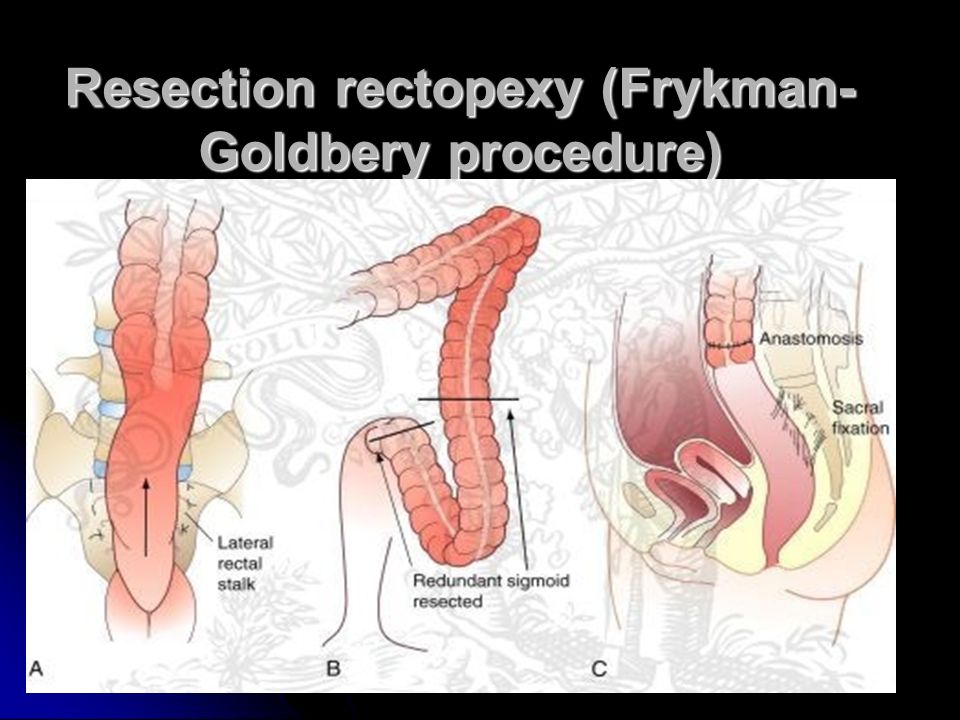How is rectal prolapse treated. Rectal Prolapse: Causes, Symptoms, Diagnosis, and Treatment Options
What are the main causes of rectal prolapse. How is rectal prolapse diagnosed. What are the treatment options for rectal prolapse. Can rectal prolapse be treated without surgery. What are the surgical approaches for treating rectal prolapse.
Understanding Rectal Prolapse: An Overview
Rectal prolapse is a condition where the rectum, the final portion of the large intestine, turns inside out and protrudes through the anus. This medical issue affects people of all ages but is more common in women and young children. While the exact cause remains unclear, several risk factors have been identified.
Types of Rectal Prolapse
Rectal prolapse is categorized into three main types based on severity:
- Internal prolapse: The rectum has prolapsed but hasn’t protruded through the anus
- Mucosal prolapse: Only the inner lining of the rectum protrudes through the anus
- External prolapse: The entire thickness of the rectum protrudes through the anus
Identifying the Symptoms of Rectal Prolapse
Recognizing the symptoms of rectal prolapse is crucial for early diagnosis and treatment. Common signs include:
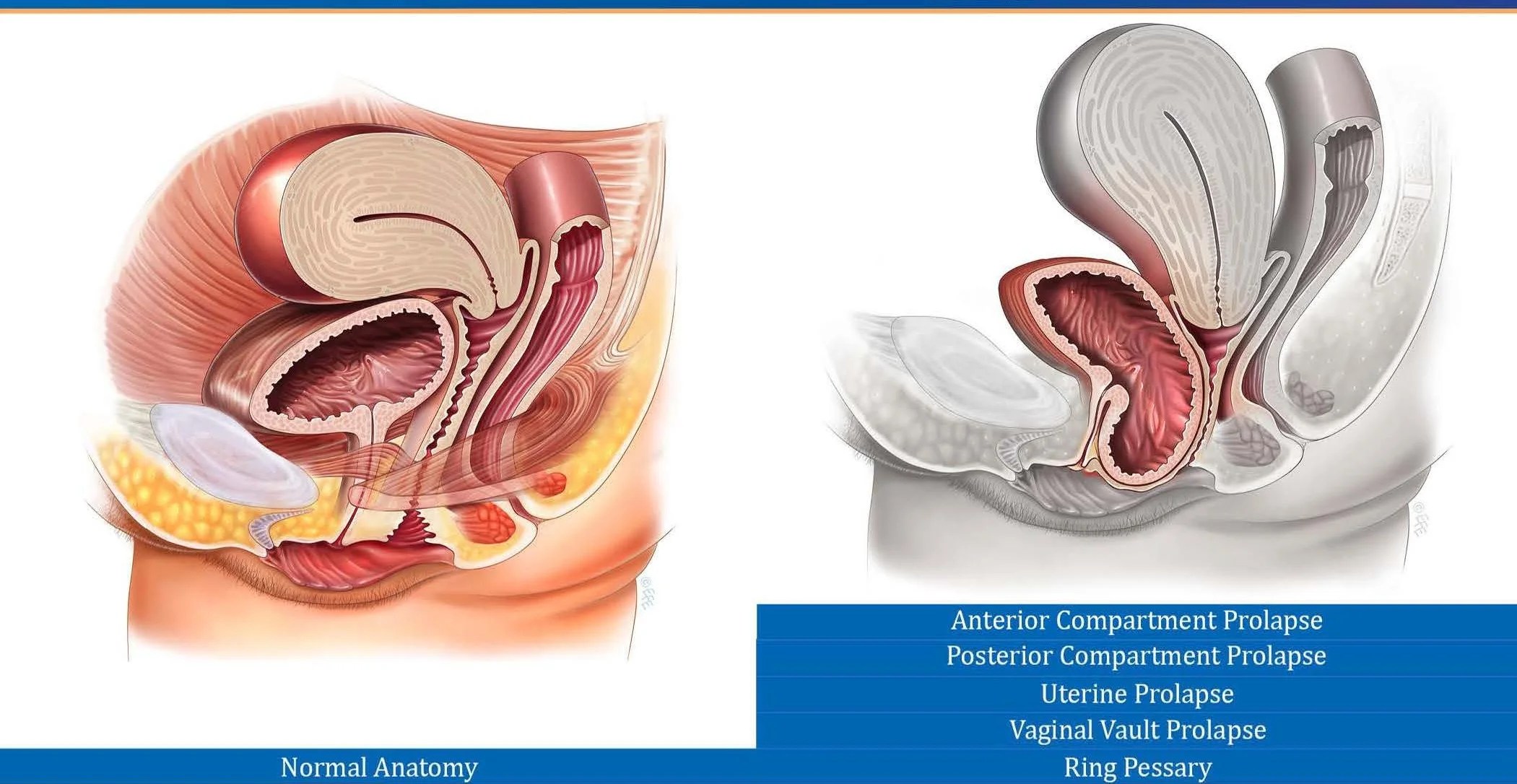
- Pain and discomfort in the lower abdomen
- Blood and mucus from the anus
- Feeling of incomplete bowel emptying
- Difficulty passing bowel movements
- Protrusion of the rectum through the anus
- Need for excessive toilet paper use
- Leakage of liquefied feces
- Fecal incontinence
Is rectal prolapse always visible. Not necessarily. In early stages, the prolapse may occur during bowel movements and retract on its own. As the condition progresses, manual repositioning may become necessary.
Exploring the Causes and Risk Factors of Rectal Prolapse
While the exact cause of rectal prolapse remains unknown, several risk factors have been identified:
- Chronic constipation and straining during bowel movements
- Weakened pelvic floor and anal sphincter muscles
- Age-related muscle weakening
- Genetic predisposition
- Parasitic infections (rare in developed countries)
- Conditions increasing abdominal pressure (e.g., benign prostatic hypertrophy, COPD)
- Structural issues with rectal ligaments
- Congenital bowel problems
- Prior lower back trauma or disc disease
Can rectal prolapse be prevented. While not always preventable, maintaining a healthy diet, staying hydrated, and avoiding straining during bowel movements can reduce the risk of developing rectal prolapse.

Diagnosing Rectal Prolapse: Methods and Challenges
Diagnosing rectal prolapse typically involves a physical examination. However, in cases where the prolapse retracts on its own, additional steps may be necessary:
- Patient may need to bear down during examination to demonstrate the prolapse
- For suspected internal prolapse, diagnostic tests may include ultrasound, specialized x-rays, and anorectal manometry
- If rectal bleeding is present, additional tests may be conducted to rule out other conditions like bowel cancer
- In children, testing for cystic fibrosis is important, as about 11% of children with rectal prolapse have this condition
Why is early diagnosis of rectal prolapse important. Early diagnosis allows for prompt treatment, potentially avoiding complications and improving outcomes.
Treatment Approaches for Rectal Prolapse
Treatment for rectal prolapse varies based on factors such as age, severity of the prolapse, and the presence of other pelvic abnormalities. Options include:

Non-Surgical Treatments
- Dietary and lifestyle changes to address chronic constipation
- Increased intake of fruits, vegetables, and whole grains
- Higher fluid consumption
- Regular exercise
- Use of surgical rubber bands to secure structures in place (for mucosal prolapse)
Can dietary changes alone treat rectal prolapse. In young children, dietary modifications to treat constipation are often sufficient to resolve rectal prolapse without the need for surgery.
Surgical Interventions
When non-surgical treatments are insufficient, surgery may be necessary to secure the rectum in place. Surgical approaches include:
- Abdominal surgery: Performed through the belly
- Perineal surgery: Conducted through the area around the anus
The choice between these approaches depends on the patient’s overall health, age, and the severity of the prolapse.
Complications Associated with Rectal Prolapse
If left untreated, rectal prolapse can lead to several complications:
- Damage to the rectum, including ulceration and bleeding
- Incarceration: The inability to manually reposition the prolapsed rectum
- Strangulation: Reduced blood supply to the prolapsed rectum
- Gangrene: Death and decay of the strangulated rectal tissue
How urgent is treatment for rectal prolapse. While not always an emergency, prompt treatment is crucial to prevent these potential complications and improve quality of life.
:max_bytes(150000):strip_icc()/102891261-56a5043a5f9b58b7d0da90be.jpg)
Living with Rectal Prolapse: Management and Support
Managing rectal prolapse involves a combination of medical treatment and lifestyle adjustments. Here are some strategies to cope with the condition:
- Follow a high-fiber diet to prevent constipation
- Stay well-hydrated
- Avoid straining during bowel movements
- Perform pelvic floor exercises as recommended by a healthcare provider
- Use stool softeners or laxatives as prescribed
- Maintain good hygiene to prevent infections
Is it possible to live a normal life with rectal prolapse. With proper treatment and management, many individuals with rectal prolapse can maintain a good quality of life and participate in regular activities.
Rectal Prolapse in Special Populations
While rectal prolapse can affect anyone, certain groups may require special considerations:
Rectal Prolapse in Children
Rectal prolapse is relatively common in children under three years of age. In most cases, it resolves on its own without surgical intervention. However, it’s crucial to address any underlying causes, such as constipation or cystic fibrosis.
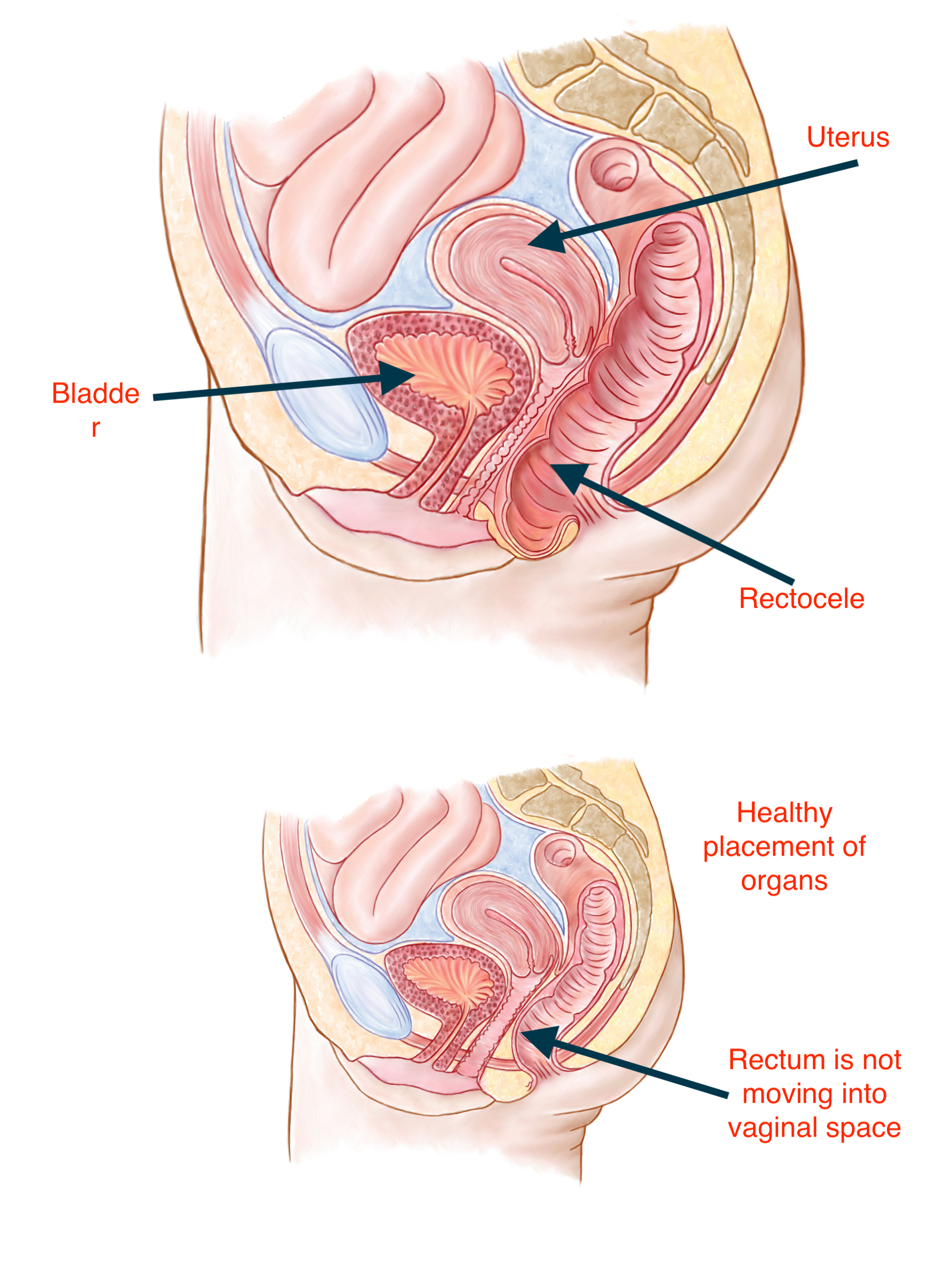
Rectal Prolapse in the Elderly
Older adults, particularly those over 65, are at higher risk of rectal prolapse due to age-related muscle weakening. Treatment in this population often requires a careful balance between surgical intervention and managing comorbidities.
Rectal Prolapse in Pregnant Women
Pregnancy and childbirth can increase the risk of rectal prolapse due to increased abdominal pressure and potential weakening of pelvic floor muscles. Management during pregnancy typically focuses on conservative measures, with surgical options considered after delivery if necessary.
How does the approach to treating rectal prolapse differ in these populations. Treatment strategies are tailored to each group’s specific needs and risks, considering factors such as growth and development in children, overall health status in the elderly, and the unique physiological changes during pregnancy.
Advances in Rectal Prolapse Treatment
Medical research continues to improve our understanding and treatment of rectal prolapse. Some recent advances include:

- Minimally invasive surgical techniques, reducing recovery time and complications
- Improved diagnostic tools for more accurate assessment of prolapse severity
- Enhanced understanding of the role of pelvic floor dysfunction in rectal prolapse
- Development of new biomaterials for surgical repair
- Exploration of regenerative medicine approaches to strengthen pelvic floor tissues
What impact have these advances had on patient outcomes. These developments have led to more personalized treatment plans, shorter hospital stays, and improved long-term results for many patients with rectal prolapse.
Preventing Recurrence of Rectal Prolapse
After successful treatment of rectal prolapse, preventing recurrence is a key concern. Strategies to reduce the risk of recurrence include:
- Maintaining a high-fiber diet and adequate hydration
- Regular pelvic floor exercises to strengthen supporting muscles
- Avoiding heavy lifting and activities that increase abdominal pressure
- Managing chronic cough or other conditions that strain the pelvic floor
- Regular follow-up with healthcare providers to monitor for early signs of recurrence
Can rectal prolapse recur after surgical treatment. While surgery is often effective, recurrence is possible, especially if underlying risk factors are not addressed. Ongoing management and lifestyle modifications are crucial for long-term success.

The Psychological Impact of Rectal Prolapse
Living with rectal prolapse can have significant psychological effects on patients. Common emotional challenges include:
- Embarrassment and social anxiety
- Depression related to chronic discomfort and lifestyle changes
- Stress about potential complications or recurrence
- Relationship difficulties due to intimacy concerns
- Body image issues
How can patients cope with the psychological aspects of rectal prolapse. Seeking support from mental health professionals, joining support groups, and open communication with healthcare providers and loved ones can help patients navigate the emotional challenges associated with rectal prolapse.
Nutritional Considerations for Rectal Prolapse Management
Diet plays a crucial role in managing rectal prolapse, particularly in preventing constipation and reducing strain during bowel movements. Key nutritional considerations include:
- Increasing fiber intake through fruits, vegetables, and whole grains
- Staying well-hydrated with water and other non-caffeinated beverages
- Avoiding foods that may cause constipation or diarrhea
- Incorporating probiotic-rich foods to support gut health
- Limiting processed foods and those high in saturated fats
How much fiber is recommended for managing rectal prolapse. While individual needs may vary, a general guideline is to aim for 25-30 grams of fiber per day for adults. It’s important to increase fiber intake gradually to avoid digestive discomfort.

The Role of Physical Therapy in Rectal Prolapse Treatment
Physical therapy, particularly pelvic floor rehabilitation, can be an essential component of rectal prolapse management. This may include:
- Kegel exercises to strengthen pelvic floor muscles
- Biofeedback training to improve muscle control
- Electrical stimulation therapy
- Techniques to improve bowel habits and reduce straining
- Education on proper posture and body mechanics
How effective is physical therapy in treating rectal prolapse. While not a standalone treatment for severe cases, physical therapy can significantly improve symptoms, enhance surgical outcomes, and reduce the risk of recurrence when combined with other treatments.
Future Directions in Rectal Prolapse Research
Ongoing research aims to improve our understanding and treatment of rectal prolapse. Some areas of focus include:
- Genetic studies to identify potential hereditary factors
- Development of novel, less invasive surgical techniques
- Investigation of tissue engineering approaches for pelvic floor repair
- Exploration of neuromodulation therapies for improved bowel control
- Long-term studies on the effectiveness of various treatment approaches
What potential breakthroughs might we see in rectal prolapse treatment in the coming years. While it’s difficult to predict specific outcomes, advances in areas such as personalized medicine, minimally invasive technologies, and regenerative therapies hold promise for improved treatment options and outcomes for patients with rectal prolapse.

Rectal prolapse – Better Health Channel
Actions for this page
Summary
Read the full fact sheet
- We do not know the exact cause of rectal prolapse, but risk factors include chronic constipation, straining to pass bowel motions, and weakened pelvic floor muscles.
- Treatment includes surgery, performed through the abdomen or via the anus, to tether the rectum into place.
- A diet that successfully treats constipation is often all that’s needed to cure rectal prolapse in young children.
The rectum is the last 20 cm or so of the large bowel. It is the temporary storage area for bowel motions. Rectal prolapse occurs when the rectum turns itself inside out and comes out through the anus. Without treatment, the rectum will eventually need to be pushed back in manually.
Women are six times more likely to suffer rectal prolapse than men. Children of both sexes under the age of three years are also commonly affected by rectal prolapse, although the prolapse tends to resolve by itself without the need for surgery.
Children of both sexes under the age of three years are also commonly affected by rectal prolapse, although the prolapse tends to resolve by itself without the need for surgery.
In the early stages of rectal prolapse, a portion of the rectum slips out while passing a bowel motion, but it goes back inside by itself.
Symptoms of rectal prolapse
The symptoms of rectal prolapse depend on the severity, but can include:
- Pain and discomfort felt deep within the lower abdomen
- Blood and mucus from the anus
- The feeling of constipation, or that the rectum is never completely emptied after passing a motion
- Difficulties passing a bowel motion
- Protrusion of the rectum through the anus
- The need to use huge quantities of toilet paper to clean up following a bowel motion
- Leakage of liquefied faeces, particularly following a bowel motion
- Faecal incontinence, or reduced ability to control the bowels.
Types of rectal prolapse
Rectal prolapse is graded according to its severity, including:
- Internal prolapse – the rectum has prolapsed, but not so far as to slip through the anus.
 This is also known as incomplete prolapse
This is also known as incomplete prolapse - Mucosal prolapse – the interior lining of the rectum protrudes through the anus
- External prolapse – the entire thickness of the rectum protrudes through the anus. This is also known as complete or full-thickness prolapse.
Causes of rectal prolapse
The exact cause of rectal prolapse is unknown, but risk factors include:
- Chronic constipation
- Straining to pass bowel motions
- Weakened pelvic floor muscles
- Weakened anal sphincter muscles
- Weakening of the muscles associated with ageing, since rectal prolapse is more common in people aged 65 years and over
- Genetic susceptibility, since it appears that some people with rectal prolapse have a blood relative with the same condition
- Parasitic infection, such as schistosomiasis – very rare in Australia
- Any condition that chronically increases pressure within the abdomen, such as benign prostatic hypertrophy, or chronic obstructive pulmonary disease (COPD)
- Structural problems with the ligaments that tether the rectum to its surrounds
- Congenital problems of the bowel, such as Hirschsprung’s disease or neuronal intestinal dysplasia
- Prior trauma to the lower back
- Disc disease in the lower back.

Complications of rectal prolapse
Complications of rectal prolapse include:
- Risk of damage to the rectum, such as ulceration and bleeding
- Incarceration – the rectum can’t be manually pushed back inside the body
- Strangulation of the rectum – the blood supply is reduced
- Death and decay (gangrene) of the strangulated section of the rectum.
Diagnosis of rectal prolapse
Rectal prolapse is diagnosed by examination. In cases where the rectum goes back inside by itself after passing a bowel motion, the person may have to bear down during examination by the doctor to show the prolapse in order to confirm the diagnosis.
In cases of suspected internal prolapse, diagnostic tests may include ultrasound, special x-rays and measurement of the anorectal muscle activity (anorectal manometry). If the person has experienced rectal bleeding, the doctor may want to do a number of tests to check for other conditions such as bowel cancer.
About 11 per cent of children with rectal prolapse have cystic fibrosis, so it is important to test young people for this condition too.
Treatment for rectal prolapse
Treatment depends on many individual factors, such as the age of the person, the severity of the prolapse, and whether or not other pelvic abnormalities are present (such as prolapsed bladder). Treatment options can include:
- Diet and lifestyle changes to treat chronic constipation – for example, more fruit, vegetables and wholegrain foods, increased fluid intake and regular exercise. This option is often all that’s needed to successfully treat rectal prolapse in young children
- Securing the structures in place with surgical rubber bands – in cases of mucosal prolapse
- Surgery.
Surgery for rectal prolapse
Surgery is sometimes used to secure the rectum into place. It can be performed through the person’s abdomen or via their anus. One operation involves tethering the rectum to the central bone of the pelvis (sacrum). Another operation is to remove the prolapsed part of the rectum and to rejoin the bowel to restore near-normal bowel function.
Another operation is to remove the prolapsed part of the rectum and to rejoin the bowel to restore near-normal bowel function.
Although surgery through the abdomen may give better long-term results, older people may be advised to undergo surgical correction via the anus, since it is easier to recover from this procedure.
Before surgery for rectal prolapse
The day before surgery, you will be asked to fast, and may need to drink a special preparation to help flush out your bowels. Once you are in hospital, the anaesthetist will visit you to see what sort of anaesthetic is best for you. You may be given medication in the hours before the operation to prepare you for anaesthesia and make you feel drowsy.
Rectal prolapse operation procedure
The various types of surgery include:
- Laparotomy (open abdominal surgery) – the surgeon uses a single, large incision (cut) in the abdomen. Then the surgeon carefully moves aside the overlying organs. To stop the rectum prolapsing, it is lifted, pulled straight and stitched directly to the inner surface of the sacrum (central bone of the pelvis).
 Sometimes, a short length of bowel may be removed
Sometimes, a short length of bowel may be removed - Laparoscopy (keyhole abdominal surgery) – laparoscopy may be possible in some cases. This involves inserting slender instruments through a number of small incisions in the abdomen. Recovery time following laparoscopy is usually quicker than open surgery
- Anal surgery – under anaesthesia, the surgeon gently pulls out the prolapsed bowel through the anus. The prolapsed section of bowel is usually removed and the structural damage repaired. The bowel is rejoined and returned back through the anus to restore normal bowel function and appearance.
Other forms of treatment for rectal prolapse
Surgery is the best option for severe rectal prolapse. Other possible forms of treatment may include:
- Lifestyle changes – including high-fibre diet, drinking plenty of water and getting regular exercise
- Change to toileting habits – such as not straining when trying to pass a bowel motion. This may require using fibre supplements or laxatives.

Immediately after surgery for rectal prolapse
After your operation for rectal prolapse or rectocele, things you can expect include:
- Hospital staff will observe and note your temperature, pulse, breathing and blood pressure.
- You will have an intravenous fluid line in your arm to replace fluids in your body.
- You will receive pain-relieving medications. Tell your nurse if you need more pain relief.
- You may have a catheter to drain off urine for the next day or so, or until you can empty your bladder by yourself.
- If you have a vaginal pack, this will be taken out later the same day or the day after surgery.
- You may be in hospital for three to six days following surgery.
- You will need to make follow-up appointments with your doctor.
Complications of surgery for rectal prolapse
Possible complications of surgery include:
- Allergic reaction to the anaesthetic
- Haemorrhage
- Infection
- Injury to nearby nerves or blood vessels
- Damage to other pelvic organs, such as the bladder or rectum
- Death (necrosis) of the rectal wall
- Recurrence of the rectal prolapse.

Taking care of yourself at home after surgery for rectal prolapse
Be guided by your doctor, but general suggestions include:
- Rest as much as you can.
- Avoid heavy lifting or straining for a few weeks.
- Don’t strain on the toilet.
- Take measures to prevent constipation, such as eating high-fibre foods and drinking plenty of water.
- After rectocele surgery, expect bloody vaginal discharge for about four weeks.
- Contact your doctor if you experience any unusual symptoms, such as difficulties with urination, heavy bleeding, fever, or signs of infection around the wound sites.
- You can expect to return to work around six weeks after surgery.
- Attend follow-up appointments with your surgeon.
Long-term outlook after surgery for rectal prolapse
While surgery through the abdomen gives better results, older people may be advised to undergo surgical correction of rectal prolapse via the anus, since this procedure is less stressful on the body.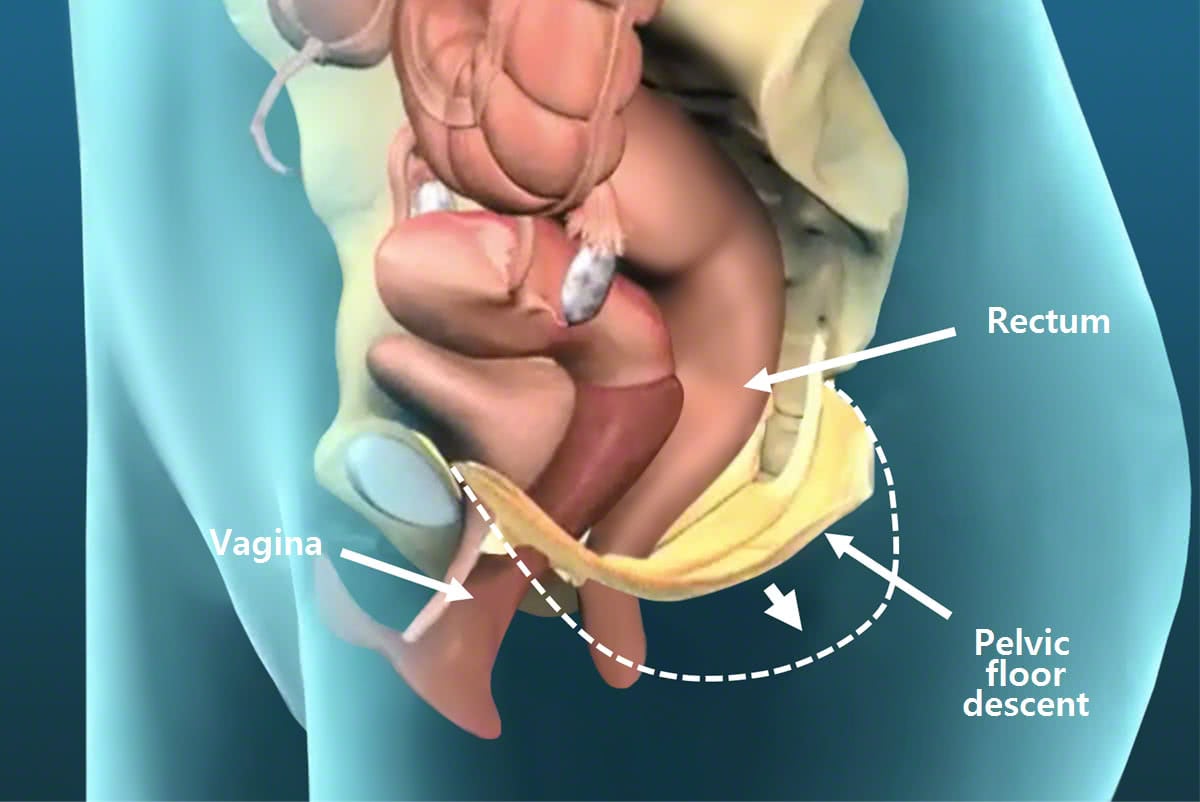
Surgery gives good results in most cases of rectal prolapse, but some people may find that symptoms such as constipation or the inability to completely empty the bowels continue.
Unfortunately for women with rectocele, the problem will recur after surgery in about 10 per cent of cases.
Where to get help
- Your doctor
- Colorectal or general surgeon
Things to remember
- We do not know the exact cause of rectal prolapse, but risk factors include chronic constipation, straining to pass bowel motions, and weakened pelvic floor muscles.
- Treatment includes surgery, performed through the abdomen or via the anus, to tether the rectum into place.
- A diet that successfully treats constipation is often all that’s needed to cure rectal prolapse in young children.
This page has been produced in consultation with and approved
by:
This page has been produced in consultation with and approved
by:
Give feedback about this page
Was this page helpful?
More information
Content disclaimer
Content on this website is provided for information purposes only. Information about a therapy, service, product or treatment does not in any way endorse or support such therapy, service, product or treatment and is not intended to replace advice from your doctor or other registered health professional. The information and materials contained on this website are not intended to constitute a comprehensive guide concerning all aspects of the therapy, product or treatment described on the website. All users are urged to always seek advice from a registered health care professional for diagnosis and answers to their medical questions and to ascertain whether the particular therapy, service, product or treatment described on the website is suitable in their circumstances. The State of Victoria and the Department of Health shall not bear any liability for reliance by any user on the materials contained on this website.
Information about a therapy, service, product or treatment does not in any way endorse or support such therapy, service, product or treatment and is not intended to replace advice from your doctor or other registered health professional. The information and materials contained on this website are not intended to constitute a comprehensive guide concerning all aspects of the therapy, product or treatment described on the website. All users are urged to always seek advice from a registered health care professional for diagnosis and answers to their medical questions and to ascertain whether the particular therapy, service, product or treatment described on the website is suitable in their circumstances. The State of Victoria and the Department of Health shall not bear any liability for reliance by any user on the materials contained on this website.
Reviewed on: 30-09-2014
Rectal Prolapse: Symptoms, Causes, Treatment, Surgery
Written by WebMD Editorial Contributors
- What Is Rectal Prolapse?
- Types of Rectal Prolapse
- Rectal Prolapse Symptoms
- Rectal Prolapse Causes
- Rectal Prolapse Risk Factors
- Rectal Prolapse Diagnosis
- Rectal Prolapse Treatment
- Rectal Prolapse Prevention
- Rectal Prolapse Complications
- More
Prolapse is when any body part slips or falls down from its normal position. Rectal prolapse is when your rectum — the last section of your large intestine — drops down or slides out of your anus. While that may sound scary, it’s typically not considered a medical emergency. However, the longer you have the condition, the worse it can get. Living with rectal prolapse can cause embarrassment and affect your quality of life.
Rectal prolapse is when your rectum — the last section of your large intestine — drops down or slides out of your anus. While that may sound scary, it’s typically not considered a medical emergency. However, the longer you have the condition, the worse it can get. Living with rectal prolapse can cause embarrassment and affect your quality of life.
If you feel like something just isn’t right when you go to the bathroom, or try to poop, you shouldn’t ignore it or make light of it. Your doctor can diagnose rectal prolapse and suggest treatment to fix it.
There are three types of prolapse:
- External prolapse: The entire rectum sticks out of your anus.
- Mucosal prolapse: Part of the rectal lining pokes out of your anus.
- Internal prolapse: The rectum has started to drop but is not yet sticking out of your anus.
If you feel like you’re sitting on a ball after pooping, or if you notice that you have something sticking out of the opening (your anus) where you poop, you could have rectal prolapse.
Typically, you’ll first experience rectal prolapse after you have a bowel movement. The first time, or first few times, the rectum may return inside on its own. Later, you may feel like something has fallen out of your body, or you just feel something down there that isn’t normal. In those cases, you may be able to push the rectum back in yourself.
Additional symptoms of rectal prolapse can include:
- Feeling a bulge outside your anus
- Seeing a red mass outside your anal opening
- Pain in the anus or rectum
- Bleeding from the rectum
- Leaking blood, poop, or mucus from the anus
Early on, rectal prolapse may look like hemorrhoids slipping out of your anal opening, but these are two different conditions. Hemorrhoids are swollen blood vessels in your anus or lower rectum that may cause itching, pain, and blood on the toilet paper when you wipe after you poop. Your doctor can diagnose whether you have rectal prolapse or hemorrhoids.
A variety of things can cause the condition, including:
- Long-term history of diarrhea or constipation
- Long-term history of having to strain when you poop
- Old age, which weakens muscles and ligaments in the rectal area
- Previous injury to the anal or hip area
- Nerve damage that affects your muscles’ ability to tighten and loosen, which could be caused by pregnancy, vaginal childbirth complications, anal sphincter paralysis, or injury to your spine or back
- Neurological problems, such as spinal cord disease or spinal cord transection
More women develop rectal prolapse than men, especially women older than 50. In general, older people who have had a history of constipation or problems with their pelvic floor have a higher chance of having the problem.
Any of these health conditions could put you at higher risk for rectal prolapse:
- Chronic constipation
- Always have to strain to poop
- Lower back injury or disc disease
- Muscle weakness in your anus or pelvic floor
- Someone in your family also had rectal prolapse
- Parasitic infections like schistosomiasis
- Chronic obstructive pulmonary disorder (COPD)
- Benign prostatic hypertrophy
- Any injury or problems with ligaments that keep your rectum attached to the intestinal wall
- Congenital bowel disorders like Hirschsprung’s disease or neuronal intestinal dysplasia
Your doctor can do a rectal exam. While you may hesitate to do this, your doctor may ask you to sit on a toilet and poop or at least try to go. This is helpful because it allows your doctor to see the prolapse.
While you may hesitate to do this, your doctor may ask you to sit on a toilet and poop or at least try to go. This is helpful because it allows your doctor to see the prolapse.
You may need some other, more advanced tests to diagnose rectal prolapse, especially if you have other related conditions:
- Anal electromyography (EMG):This test checks to see if nerve damage is causing your anal sphincter problems.
- Anal manometry: A thin tube is inserted into your rectum to test muscle strength.
- Anal ultrasound: A probe inserted into your anus and rectum is used to examine muscles and tissues.
- Pudendal nerve terminal motor latency test: It checks your pudendal nerves, which you use to control bowel movements.
- Proctography:X-ray videos of your rectum during a poop show how well it holds and releases feces.
- Colonoscopy: A long tube inserted into your rectum with a tiny camera at the end can show the inside of your intestines and look for any problems that may be causing your prolapse.

- Proctosigmoidoscopy:This test also uses a long tube with a camera on the end. It’s inserted deep into your intestines to look for inflammation, scarring, or a tumor.
- MRI: Imaging scan examines all of the organs in your pelvic area.
The most common treatment for rectal prolapse is surgery to put the rectum back in place, and there are several types. The kind of surgery your doctor recommends will depend on factors such as your overall health, age, and how serious your condition is. The two most common types of surgery:
- Abdominal: This type of surgery can be done either with a large incision or using laparoscopy, which uses small cuts and a camera attached to an instrument so the surgeon can see what needs to be done and if there are any additional issues that need to be fixed.
- Perineal: Also called rectal repair, this approach may be used if you are older or have other medical problems.
 This type of surgery can involve the inner lining of the rectum or the portion of the rectum extending out of the anus.
This type of surgery can involve the inner lining of the rectum or the portion of the rectum extending out of the anus.
If your rectal prolapse is very minor and it is caught early, your doctor might have you treat it by taking stool softeners to make it easier to go to the bathroom and by pushing the rectum’s tissue back up the anus by hand. But, typically, you will eventually need to have surgery to fix rectal prolapse.
To prevent rectal prolapse, try not to strain when you poop. Try these tips to ease or prevent constipation that leads to straining:
- Get more fiber in your diet. Aim for at least five servings of fruits and veggies each day.
- Drink 6 to 8 glasses of water a day.
- Get regular exercise.
- Keep your weight at a healthy level or lose weight if you need to.
- If you have constipation often, talk to your doctor. They may direct you to take a stool softener or laxative.
Avoid heavy lifting, as this could put pressure on your bowel muscles.
Rectal prolapse, if it’s not treated, could lead to these complications:
- Rectal damage like ulceration or bleeding
- Your rectum can’t be manually pushed back up inside you
- Strangulation, or the blood supply in your rectum is reduced
- Gangrene, or the strangulated rectal tissue decays and dies
Top Picks
Prolapse of the rectum — City Hospital №40
Hippocrates, John Rolanius, Ambroise Pare and many other doctors of the past centuries described rectal prolapse under various designations./what-is-a-rectopexy-4582499_final-268bc0a4ed1940fe98c4cf9ce5e9e6d7-d30f2a0f0a964a839ef6767ba7576678.png)
This name refers to the prolapse of all layers of the rectal wall through the anal ring.
In the 18th century, Morgagni considered the cause of the prolapse to be the weakness of the “suspending ligaments” of the rectum, while other well-known anatomists and surgeons (J. Hunter, Albrecht Haller) attached leading importance in the cause of prolapse to the introduction (invagination) of the rectum into its lower Department.
Hence the hernia theory of the disease (Moschowitz), which dominated for a long time.
In a fundamental review of the history and current state of the problem of pathogenesis and treatment of rectal prolapse R.Madoff a. A. Mellgren (1999) write that back in 1831, the founder of the world-famous St. Mark’s Proctological Hospital in London, F. Salmon, wrote that there are two causes of rectal prolapse – constitutional and local.
The author attributed constipation, diarrhea, malnutrition with concomitant asthenia, inadequate physical activity to the first, and to the second, the most important from his point of view, spasm or strictures of the rectum, leading to “obstructive” defecation.
Even then he recommended conservative (enemas, bandages, bougienage, sphincter divulsion) and operative measures – fixation of the intestine with perineal access with excision of the prolapsed mucosa. Since then, the pathogenesis of the disease has been studied fundamentally, and approaches to its treatment have changed many times, although there are very few real randomized trials. It can be said that complete prolapse of the rectum is a combination of atony of the pelvic floor with a gaping anus, although the causes and significance of both factors in this pathology have not yet been fully elucidated.
From 50 to 70% of patients with prolapse suffer from fecal incontinence, and in special studies using needle electromyography, an inhibited pelvic floor reflex was recorded, and in histological examination of biopsies in these tissues, a clear dysfunction of the proximal branches of the pudendal nerve was expressed, which, apparently, , is injured during various surgical attempts at anal reconstruction.
Other studies – anal manometry, determination of the degree of loss of sensory rectal sensations, etc. – found out some possible links in the pathogenesis of rectal prolapse, although, for example, its connection with constipation is less clear than the combination of prolapse with anal incontinence.
In general, the theoretical part of the problem is far from being solved. The clinic of the disease consists of persistent constipation (often starting in childhood) and other difficulties in defecation, fecal discharge on linen (calomania), pulling pains in the pelvis and the presence of the prolapsed section of the intestine of different lengths. All this is combined with varying degrees of anal insufficiency.
Classification . There are 4 types (degrees, stages, forms) of rectal prolapse:
- partial, i.e. prolapse of mucous membrane only,
- complete with eversion of the mucocutaneous border (dentate line) of the anal canal,
- complete without eversion of this line,
- latent (internal) prolapse – invagination of the rectum into the anus.

Etiology
The etiology of rectal prolapse appears to be multifactorial (see above), but at least two main theories can be distinguished.
A. Moschcowitz (1912) considered this disease to be a form of hernia of the Douglas space: with an increase in intra-abdominal pressure, the anterior wall of the rectum invaginates into its lumen and subsequently, with the continuation of this factor, the intestinal wall and the surrounding pelvic tissues prolapse through the muscles-elevators of the anus . Clinically, indeed, sometimes through the prolapsing part of the rectum, you can feel the small intestine in this bag. The second theory (B. Broden, B. Snellman, 1968) interprets prolapse of the rectum as its primary invagination. Based on film radiography data, these authors showed that there is a “main point” of intussusception, at a height of 6-8 cm from the anus, not higher.
In the end it was concluded that Moschcowitz’s sliding hernia theory was also correct: the enterocele is a late manifestation of intussusception.
Several factors contribute to rectal prolapse; this is a deep Douglas space, diastasis of the levator muscles, an elongated rectosigmoid section of the colon, weak fixation of the rectum with ligaments to the sacrum, an elongated mesentery of the transverse colon.
It is known that during rectal prolapse, the sphincter often gapes, and anal incontinence occurs, which also contributes to the protrusion of the prolapsed part into the lumen of the rectum. An important etiological factor is also birth trauma of the anal sphincter, unsuccessful operations for complex fistulas of the rectum.
Clinical picture. The clinic of the disease develops, as mentioned above, from the growing incontinence of gases and liquid feces and the appearance of a protrusion from the anus, first during defecation, and then when coughing and walking.
Gradually, the intestine ceases to be set either by itself or by hand, a constant feeling of moisture appears, mucus, blood is released, anal itching appears. Colonoscopy reveals swelling and mobility of the intestinal walls above the level of 6-8 cm from the anus.
Colonoscopy reveals swelling and mobility of the intestinal walls above the level of 6-8 cm from the anus.
Irrigoscopy and cine radiography can reveal intussusception of the sigmoid into the rectum.
Diagnosis
Differential diagnosis is carried out mainly with hemorrhoids with internal prolapse.
The main differences are that the length of the prolapsed column during prolapse can be up to 15 centimeters or more, while with hemorrhoids the prolapsed area cannot be longer than 2-3 cm and, in addition, when the intestine prolapses, the entire structure of its internal is visible walls (transverse folds), and with hemorrhoids, the “bouquet” of drop-down nodes is divided into lobes and the dentate line of the anal canal does not turn out. These clear differences, however, do not always contribute to the correct diagnosis, and we have repeatedly seen patients with the first degree of prolapse of the rectum, operated on for hemorrhoids, and vice versa. It is clear that such operations are inadequate.
It is clear that such operations are inadequate.
In the differential diagnosis, it is necessary to remember about the prolapse of tumors from the rectum (large pedunculated polyps). In children (up to 2-3 years old), the introduction of a glycerin suppository is used for diagnosis, which causes the urge to defecate and you can see the shape and length of the prolapsed intestine. It is clear that in all cases a digital examination of the rectum and rectoscopy are necessary to exclude prolapsed polyps.
Differential diagnosis of hemorrhoids with prolapse of internal nodes and initial forms of prolapse of the rectum is difficult; it is based on the different lengths and shapes of the dropouts. Operations for rectal prolapse are fundamentally different from hemorrhoid surgery, and surgical treatment of any degree of rectal prolapse should be carried out in a specialized proctology clinic.
Treatment .
Treatment of the initial forms of rectal prolapse can be conservative, but experience shows that all these measures, including pararectal injections of sclerosing drugs, sphincter and pelvic floor muscle stimulation, physiotherapy, etc. , do not guarantee success. You need to operate, and the sooner the better.
, do not guarantee success. You need to operate, and the sooner the better.
The exception is children, in whom the operation should not be rushed. Very important in this situation is a diet with a lot of fiber (bran), patient training of the child to have a stool at the same time, the correct water toilet after defecation. In case of a sudden first episode of rectal prolapse in a child, it is recommended to carefully try to set it in place, without putting much effort in order to avoid injury to the mucosa.
In the literature, one can find from 30 to 50 operations for rectal prolapse, which are considered by their authors to be the most adequate. Let us name only such well-known and still used methods as narrowing of the anal ring according to Thiersch, sleeve excision of the prolapsed mucosa according to Delorme, perineal excision of the prolapsed part of the rectum according to Mikulich, 26 different operations proposed by Moskovich, rectosigmoidectomy according to Miles, suturing of the anterior wall of the rectum to the sacrum like a belt (Ripstein operation).
At present, efforts are continuing to finally find the optimal operating aid. It is necessary to look for it, because, according to the literature, relapses after various operations are high: after intra-abdominal interventions they are the least, but within 10%, after perineal rectosigimoidectomy – up to 60% and after Delorme’s operation – up to 40%, and anal incontinence persists after intra-abdominal interventions. operations in 60-80% and after various perineal corrective operations in 40-60% of patients (R. Madoffa. A. Mellgren, 1999).
Contraindications
Only general contraindications to surgery — severe lesions of vital organs and systems, coagulopathy, but not senile age; With modern methods of anesthesia, it is possible and necessary to operate on patients with rectal prolapse of any age.
Presacral rectopexy is the most widely used in our country. In patients with concomitant anal incontinence (a very common variant), the operation is supplemented with sphincter-levatoroplasty.
Other operations for rectal prolapse – obliteration of the deep Douglas space, elimination of diastasis of the levator muscles, sigmoidopexy (including tape), posterior loop rectopexy, rectoplication, operations using an ivalon sponge, narrowing of the anus according to Thiersch, removal of the mucous membrane of the prolapsed section of the rectum with subsequent plication to shorten the anorectal section (Delorme operation) – are currently rarely used, only for special indications.
Even superradical surgeries such as anterior resection of the rectum or resection of the long sigma are proposed, but these interventions are unlikely to be pathogenetically justified, because many factors are involved in the mechanism of rectal prolapse, and the length of the prolapsed part itself does not play a leading role. In this regard, one should critically approach the advice of some foreign proctologists (S.Nivatvongs, 1995) to apply resection of the sigmoid colon and transperineal resection of the rectum more often in case of rectal prolapse.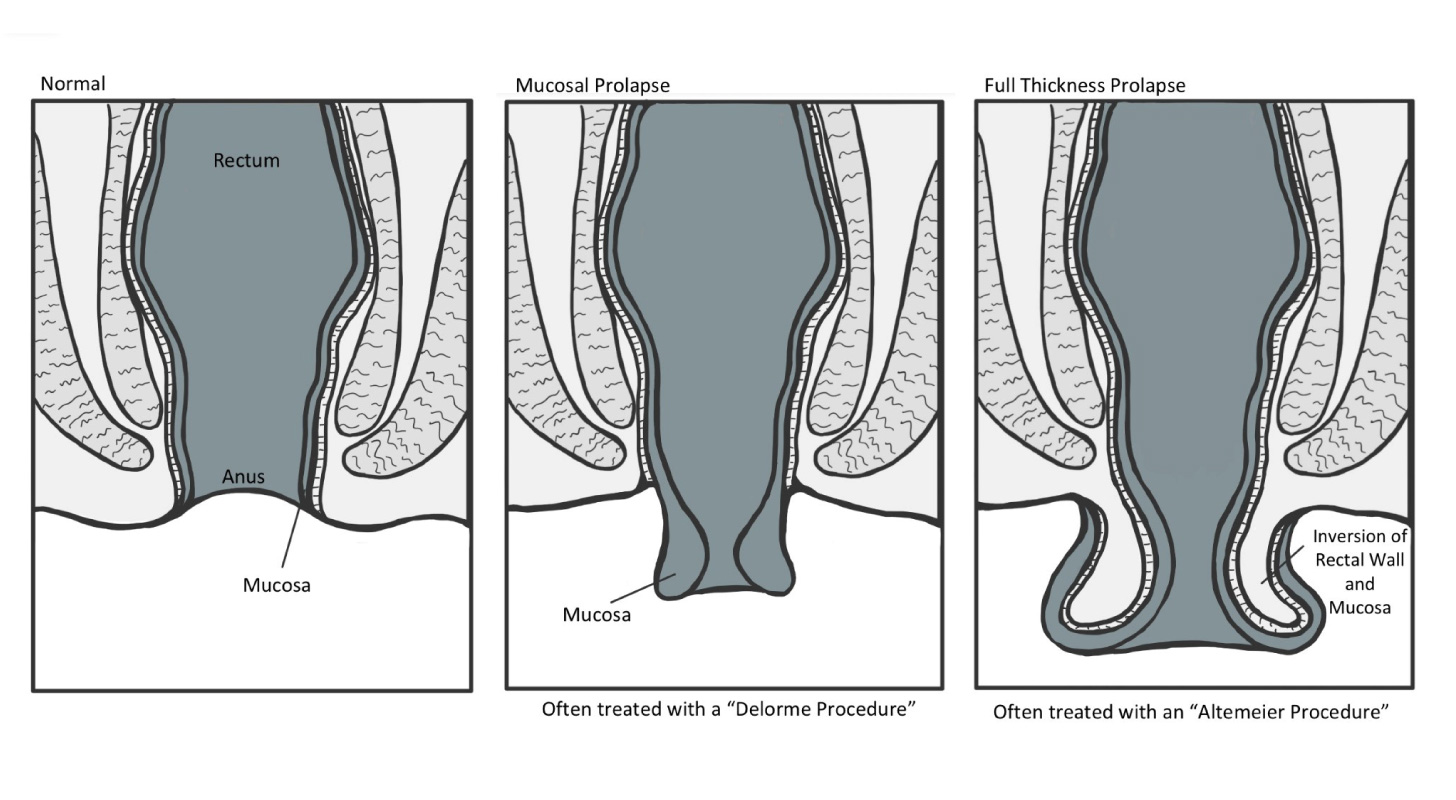
Treatment of rectal prolapse in children
Treatment of rectal prolapse in children has important features. Above, we have already indicated that with such a sudden prolapse, you can try to carefully set the intestine, trying not to injure the mucosa.
This technique can be taught to the mother of the child; the intestine is set in the position of the child’s body on the back, pouring vaseline oil on the fallen area. After reduction, the child is placed on the stomach and the buttocks are reduced (or fixed with tapes of an adhesive patch). In children under 5 years of age, and in older children with initial prolapse, treatment is mainly conservative.
First of all, it is the prevention of constipation, diarrhea and general strengthening therapy (enhanced nutrition, vitamins, outdoor recreation, etc.). Then – very importantly – try to teach the child to defecate while lying on his back or in a position on his side, or even standing. This minimizes abdominal tension. This requires patience, especially from parents. It is also very important to strengthen the muscles of the anus – active physiotherapy, electrical stimulation, physiotherapy exercises.
This requires patience, especially from parents. It is also very important to strengthen the muscles of the anus – active physiotherapy, electrical stimulation, physiotherapy exercises.
This complex therapeutic treatment should be carried out for at least 2 weeks, sometimes for 3-4 months. In children older than 5 years and with unsuccessful conservative treatment, sclerosing therapy is relatively favorable. Manipulation requires scrupulousness, because if alcohol enters the intestinal wall or if too much of it is in one area, severe tissue necrosis may occur. As for the surgical treatment of rectal prolapse in children, most pediatric surgeons prefer rectofixation according to Kümmel-Zerenin in the modification of A.N. Ryzhikh.
Perineal prolapse syndrome
There are two pathological conditions pathogenetically associated with rectal prolapse.
The first one is perineal drooping syndrome. This is a disorder of pelvic floor function, more common in women with rectal prolapse.
At the same time, on contrast radiographs of the pelvis in lateral positions, one can note the location of the anal canal and rectum below the pelvic bone skeleton compared to the norm; the plane of the perineum when straining is located below the ischial tubercles. The clinic of the syndrome consists mainly in difficulties with defecation – prolonged futile attempts and a feeling of incomplete emptying. The pelvic floor descends, the anorectal angle changes, and with it the so-called. anorectal valve mechanism. The latter is associated with flattening of the walls of the rectum when it passes through a slit-like opening in the pelvic floor, when the puborectalis muscle pulls the intestine forward.
This mechanism contributes to the protrusion of the anterior wall of the rectum into the lumen of the anal canal, for example, during straining.
Such patients are forced to resort to a manual aid during defecation – to push this valve out of the mucous membrane with a finger.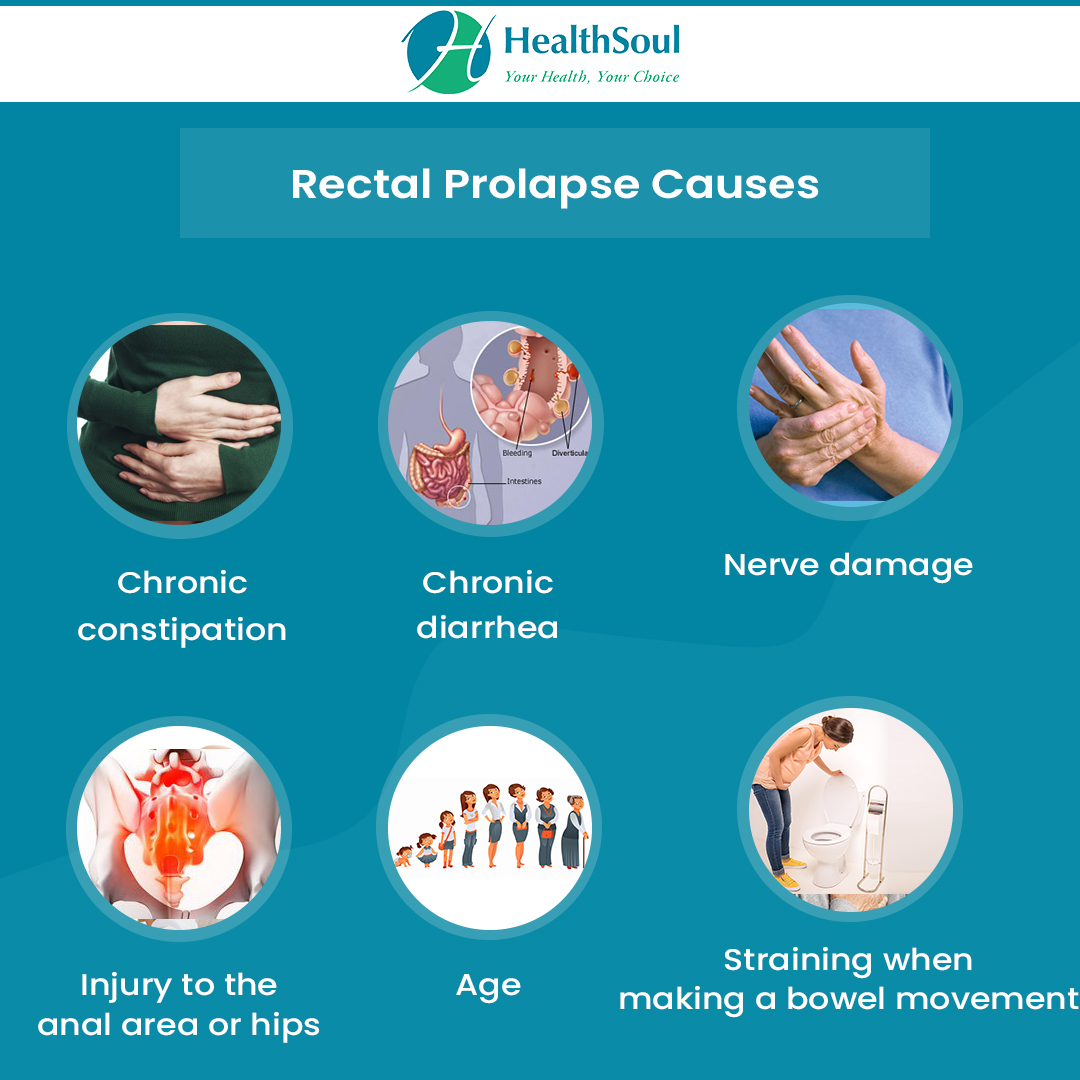 In this case, of course, mucus and blood are released. In women, this condition is sometimes associated with stress incontinence and vaginal prolapse. The treatment of the syndrome is multifaceted – the prevention of constipation, the explanation of the harmfulness of attempts, sclerotherapy and excision of the prolapsed mucosa, but, as world experience shows, the treatment of this syndrome does not give a lasting effect.
In this case, of course, mucus and blood are released. In women, this condition is sometimes associated with stress incontinence and vaginal prolapse. The treatment of the syndrome is multifaceted – the prevention of constipation, the explanation of the harmfulness of attempts, sclerotherapy and excision of the prolapsed mucosa, but, as world experience shows, the treatment of this syndrome does not give a lasting effect.
Solitary rectal ulcer
The second pathological condition closely related and often considered in conjunction with the problem of prolapse is solitary rectal ulcer.
A solitary ulcer of this localization is a chronic benign lesion, occurs often in young people and is manifested by bloody and mucous secretions.
General status does not change.
On digital examination, it is possible to determine a thickening of the nodular or villous form and a slight pathological mobility of the mucous membrane of the lower part of the anterior rectal wall, near the anorectal line.
At endoscopy, the ulcer is superficial, as if stamped, gray-white in color with a small, several millimeters wide, zone of hyperemia. Sometimes the ulcer captures the valves of the Morganian crypt.
Ulcers vary in size from millimeters to several centimeters, and their localization is most often at a height of 4 to 12 cm, only on the lower part of the anterior wall of the rectum.
Many authors believe that solitary ulcer is closely related to rectal prolapse, that this is one of its symptoms. Biopsy of the mucosa surrounding the ulcer reveals replacement of the normal basement membrane by fibroblasts and smooth muscle cells from the muscle layer of the mucosa.
Rectal prolapse is often associated with perineal prolapse and solitary rectal ulcer syndrome. The pathogenesis of the first combination is clear, while the occurrence of a solitary ulcer of the rectum with its prolapse remains unexplored. This is a benign disease that is not subject to radical surgery.
The picture may resemble either a smooth muscle tumor, or cystic colitis, or an invasive cancer with collagenous substances.
In general, a permanent and pronounced sign of the syndrome of solitary rectal ulcer is the prolapse of the mucous membrane, its displacement from the submucosal layer.
Hence the most likely pathogenesis of this syndrome: constant long-term straining during defecation (regardless of the reasons) shifts the anterior wall of the rectum (fixed worse than the posterior one) into the anus and other pathological factors arise, including ischemia, fibrosis, trauma, leading to eventually to ulceration.
The treatment is purely individual. If signs of rectal prolapse prevail, then the doctor’s efforts should be aimed at correcting the prolapse, and not at healing the ulcer.
Local excision of the ulcer will not lead to anything. If conservative therapy fails (reorganization of the defecation system, prevention of flatulence, suppositories, enemas, sulfasalazine, steroid hormones), various sclerosing injections, photocoagulation, cryotherapy, ligation of prolapsed mucosal sections with latex rings, excision of the prolapsed anterior rectal wall using a technique close to surgery are resorted to. Milligan-Morgan for hemorrhoids.
Milligan-Morgan for hemorrhoids.
At this stage, it is impossible to recommend any optimal regimen for the treatment of solitary rectal ulcer.
Prolapse of the rectum (rectal prolapse)
Article rating
0 (Voted: 0)
Contents
- What you need to know about rectal prolapse (rectal prolapse)?
- What is rectal prolapse?
- Why does rectal prolapse occur?
- How does rectal prolapse manifest itself?
- How to recognize bowel prolapse?
- What will happen if not treated?
- Treatment of rectal prolapse
- Conservative treatment
- Surgical treatment
- How the operation works
- Transabdominal surgery
- Perineal surgery
- Rectosigmoidectomy
- Questions to ask your surgeon before starting treatment
What should I know about rectal prolapse (rectal prolapse)?
This information is intended to help you better understand what rectal prolapse (rectal prolapse) is. It can be useful for patients suffering from rectal prolapse or rectal prolapse, as well as their friends, relatives and caregivers during their illness. We strive to help you understand what kind of disease it is, assess the severity of your condition and introduce you to treatment methods. Treatment often requires surgery, and this resource outlines why surgery may be recommended, what the different treatment options are, what it involves, and how we can help.
It can be useful for patients suffering from rectal prolapse or rectal prolapse, as well as their friends, relatives and caregivers during their illness. We strive to help you understand what kind of disease it is, assess the severity of your condition and introduce you to treatment methods. Treatment often requires surgery, and this resource outlines why surgery may be recommended, what the different treatment options are, what it involves, and how we can help.
What is rectal prolapse?
Rectal prolapse (the last part of the colon before exiting the anus) is a condition caused by weakness of the musculoskeletal apparatus of the pelvis, causing the intestine to “turn inside out” out through the anus. The disease rarely leads to serious medical problems, but significantly affects the level of quality of life.
In general, rectal prolapse is a rare pathology (2.5 cases per 100,000 people). This disease occurs mainly in adults, and women over 50 are six times more likely to develop rectal prolapse than men. Most women with rectal prolapse are over 60 years old, while men are on average 40 years old or younger. These younger patients are more likely to have autism, developmental delay, and psychiatric problems requiring multiple medications. Although surgery is not always required for this disease, conservative tactics do not provide a complete cure. For the radical treatment of rectal prolapse, surgical intervention is required.
Most women with rectal prolapse are over 60 years old, while men are on average 40 years old or younger. These younger patients are more likely to have autism, developmental delay, and psychiatric problems requiring multiple medications. Although surgery is not always required for this disease, conservative tactics do not provide a complete cure. For the radical treatment of rectal prolapse, surgical intervention is required.
Why does rectal prolapse occur?
The cause of rectal prolapse is associated with a number of factors, sometimes there are several provoking factors. Chronic constipation (infrequent stools or heavy straining) is present in 30-67% of patients, with a further 15% experiencing diarrhea. It is possible that the development of rectal prolapse is a consequence of multiple natural births; although up to 35% of women with rectal prolapse have never had children. The disease can also occur due to hereditary predisposition.
How is rectal prolapse manifested?
Rectal prolapse tends to develop gradually in most cases. At first, during the act of defecation, only the mucous membrane falls out, which soon itself goes back into the anus. At this time, patients describe “something falling out of the anal canal.” Prolapse of the rectum is accompanied by a sensation of a foreign body in the anus. In the initial period, rectal prolapse can be confused with a significant hemorrhoid, and sometimes even doctors can be confused.
At first, during the act of defecation, only the mucous membrane falls out, which soon itself goes back into the anus. At this time, patients describe “something falling out of the anal canal.” Prolapse of the rectum is accompanied by a sensation of a foreign body in the anus. In the initial period, rectal prolapse can be confused with a significant hemorrhoid, and sometimes even doctors can be confused.
Once prolapse becomes apparent, fecal incontinence (the inability to hold solid, liquid stools and gases in the anus) occurs in 50-75% of cases and is associated with a number of factors. The anal sphincter is a structure made up of many muscles that help keep feces in the intestines. When the rectum prolapses, the anal sphincter does not perform its function, and because of this, stool and mucus pass out of the rectum uncontrollably. Damage to the pudendal nerve is present in many patients with prolapse. The pudendal nerve controls the anal sphincter. Damage to it can be the result of direct trauma (birth injury), chronic diseases such as diabetes, as well as a back injury or surgery. In addition, the anal sphincter is constantly stretched due to the prolapse itself, which becomes an additional risk factor.
In addition, the anal sphincter is constantly stretched due to the prolapse itself, which becomes an additional risk factor.
Between 25% and 50% of patients report constipation. The constipation that accompanies rectal prolapse occurs as a result of a disruption in the anatomy of the rectum, as if turning into itself, creating both a mechanical “blockage” and aggravated by tension, general coordination problems of the entire pelvic floor and problems with the ability of the colon to propel chair forward at normal speed. Over time, the prolapsed rectal mucosa can thicken and ulcerate, causing severe bleeding.
How to recognize bowel prolapse?
To diagnose bowel prolapse, a thorough history and physical examination of the patient is essential. Particular attention is paid to complaints of constipation, fecal incontinence and any complaints of urinary incontinence or vaginal protrusion. Direct examination of the anal area is very important and often reveals a decreased tone of the anal sphincter (the sphincter appears “relaxed”). The patient may be asked to contract and relax their anal sphincter while the doctor holds a finger in the patient’s anal canal or buttock. This helps the doctor understand how the anal sphincter works. Sometimes anal manometry (direct measurement of anal sphincter pressure) may be prescribed.
The patient may be asked to contract and relax their anal sphincter while the doctor holds a finger in the patient’s anal canal or buttock. This helps the doctor understand how the anal sphincter works. Sometimes anal manometry (direct measurement of anal sphincter pressure) may be prescribed.
Rectal prolapse and hemorrhoids are not easy to differentiate. In order to assess rectal prolapse, the patient may be asked to strain while watching him while squatting on the toilet. Although this can be somewhat confusing for patients, it is important to make an accurate diagnosis, as the treatment for hemorrhoids and rectal prolapse is very different.
In the process of making a diagnosis, instrumental methods are also used. Colonoscopy is often necessary to rule out any comorbidities, polyps, or cancer before surgical treatment of rectal prolapse is considered. This is a procedure that uses a special instrument called a colonoscope to examine the entire inside of the large intestine.
If the diagnosis remains in doubt, defecography is performed. During the study, the patient is injected with a radiopaque paste, then he sits on a special toilet chair and X-rays are taken of sequential actions: rest, hold, straining, emptying the intestine. As already mentioned, rectal prolapse can occur against the background of a general failure of the pelvic floor muscles. Between 20 and 35% of patients with rectal prolapse complain of urinary incontinence, and 15% of women experience rectal prolapse (a feeling that something is sticking out into the vagina). These additional problems can also be identified by defecography.
Many people with rectal prolapse experience constipation. It is important to note that depending on the severity of the patient’s symptoms, they may be asked to undergo a special examination (passage of a radiopaque substance through the intestines) to assess the ability of their colon to pass stool. Several X-rays are taken over five days to see how the contrast travels through the small and large intestines, which is called “time of passage. ”
”
What happens if you don’t treat?
Patients who choose to do nothing after diagnosis (especially early in the course) can expect the extent and frequency of prolapse to increase over time, and the rectal prolapse itself to be milder (may just prolapse on standing). If the patient delays treatment for an extended period of time, he should be aware that the longer the time passes, the greater the chance of irreversible fecal incontinence problems as the anal sphincter is constantly stretched and the chance of nerve damage also increases. The length of time it takes for these changes to occur varies greatly from person to person. In some cases, the prolapse is minor or surgery is contraindicated for the patient. In these cases, supportive clothing can help prevent permanent or intermittent shedding. Without treatment, rectal prolapse does not develop into cancer.
Treatment of rectal prolapse
Conservative treatment
All methods of conservative treatment of rectal prolapse, including manual reduction of the organ, pararectal administration of sclerosing drugs, electrical stimulation of the pelvic floor muscles and sphincter, do not guarantee a complete cure for the patient. They can only be used in young people only at the initial stage of the disease. But even under such conditions, it is impossible to guarantee a 100% complete cure and the absence of relapses in the future.
They can only be used in young people only at the initial stage of the disease. But even under such conditions, it is impossible to guarantee a 100% complete cure and the absence of relapses in the future.
Surgical treatment
Radical treatment of rectal prolapse is possible only surgically. There are two main approaches for the surgical treatment of this disease – transabdominal operations (through the abdomen) and perineal operations (through the perineum). Both approaches aim to prevent the recurrence of prolapse and usually result in a significant improvement in quality of life.
The choice of the type of operation depends on two factors: the characteristics of the patient himself, and the severity of the disease. The former include the patient’s age, gender, bowel function, urinary incontinence, prior surgeries, and the severity of associated medical problems. The second includes: the degree of prolapse, what impact the intervention may have on bowel function and urinary incontinence, complication rates, recurrence rates, and the surgeon’s individual experience.
Most surgeons will agree that the abdominal approach provides the best chance for long-term successful treatment of rectal prolapse. The perineal approach is often better suited for very elderly patients, or patients with very severe comorbidities. For younger men, a perineal approach may also be considered, as there is a small chance (1-2%) of causing sexual dysfunction due to nerve damage during an abdominal approach. Although not typical, it should be considered when deciding on the type of operation.
How the operation works
Surgical interventions for rectal prolapse can be performed under various types of anesthesia. The patient and surgeon decide what is appropriate for a given patient based on their particular circumstances. Possible options:
- General anesthesia (full sleep with a “breathing tube” in place).
- Spinal anesthesia (similar to epidural injection during childbirth).
- Combination of intravenous relaxants and local anesthesia (painkillers) given around the anus after taking relaxants.

Doctors of the University Clinic of Moscow State University. M.V. Lomonosov during a surgical operation on the rectum
Transabdominal surgery
Most abdominal techniques involve an incision in the lower abdomen and separation of the rectum from the surrounding tissue. Then a rectopexy is performed, in which the rectum is pulled up and attached to the sacrum (back wall of the pelvis) in various ways. Depending on the preferences of the surgeon, the rectum can be fixed with sutures or with a special mesh to the anterior surface of the sacrum. Regardless of the specific technique used, the goal is to keep the rectum in the appropriate position until it is fixed there with new scars. In general, both of these methods give very good results: recurrence (repeated) rectal prolapse occurs in about 2-5% of cases.
It is important to note that while prolapse can be corrected, fecal incontinence or constipation cannot always be cured.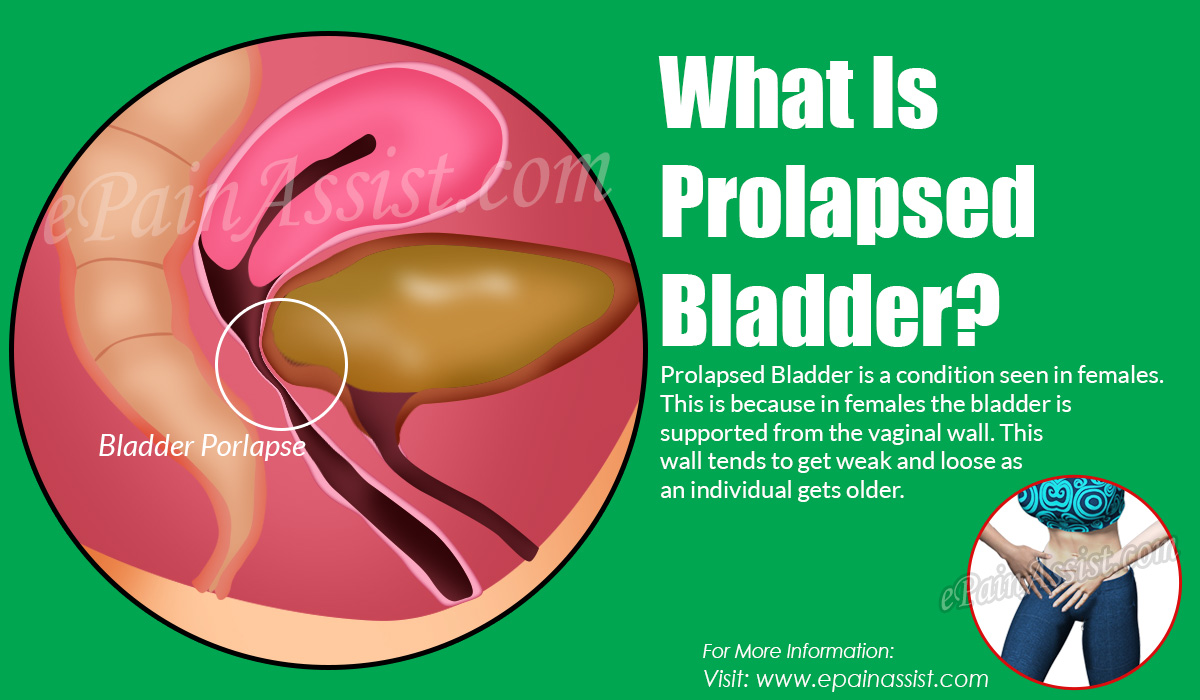
In recent years, the popularity of minimally invasive methods, such as laparoscopic or robotic interventions, has increased. Laparoscopy is a method in which the surgeon gets to the operated area without the use of large incisions. Two small incisions are made in the abdominal cavity, through which special instruments with optics and a light source are inserted. The surgeon observes the operated area on the monitor screen. In this case, the same procedures are performed as for abdominal accesses described above.
One of the promising areas for the development of minimally invasive surgery has been the introduction of robot-assisted operations into practice. In each of these cases, the operation performed is identical to open access. Potential benefits of minimally invasive techniques include: reduced trauma and blood loss, reduced pain, shorter hospital stays, and earlier return to full activity and work. Not all surgeons have the experience or knowledge to perform these surgeries and therefore they are not always available.
Perineal operations
Perineal access allows to reduce the percentage of postoperative complications and trauma, as well as to reduce the length of stay in the hospital, compared with transabdominal interventions. Until recently, these benefits were thought to be offset by a higher recurrence rate. However, properly performed perineal surgery can give good long-term results.
Rectosigmoidectomy
The most common perineal approach is often referred to as perineal rectosigmoidectomy or the “Altemeier procedure”, named after the surgeon who popularized the operation. This approach to the surgical treatment of rectal prolapse is performed through the anus without an abdominal incision. In the operating room, the rectum is deliberately forced to protrude. Produce a circular incision throughout the thickness of the intestinal wall. Next, the excess mucosa is cut off, after which a hardware or manual anastomosis is applied (connection of the large intestine to the anus). The absence of an abdominal incision, minimal trauma, and a shorter hospital stay make this a treatment option of choice for elderly patients with severe comorbidities. This technique has a higher recurrence rate (>10%) than abdominal approaches (2–5%), with complication rates ranging from 5% to 24% and include bleeding and pelvic infection. Fecal incontinence may be more of a problem after this procedure compared to abdominal rectopexy, although most patients have already had urinary incontinence. The task of the rectum is to serve as a reservoir for stool, and this procedure removes the rectum. As a result, the colon is now doing the work of the rectum, and it may not be able to hold stool as well as the rectum itself. To solve this problem, levatoroplasty can be performed. Levatoroplasty is performed at the same time as a perineal rectosigmoidectomy and involves “tightening” the pelvic floor muscles by stitching some of them closer together. It helps fecal retention in two-thirds of patients.
The absence of an abdominal incision, minimal trauma, and a shorter hospital stay make this a treatment option of choice for elderly patients with severe comorbidities. This technique has a higher recurrence rate (>10%) than abdominal approaches (2–5%), with complication rates ranging from 5% to 24% and include bleeding and pelvic infection. Fecal incontinence may be more of a problem after this procedure compared to abdominal rectopexy, although most patients have already had urinary incontinence. The task of the rectum is to serve as a reservoir for stool, and this procedure removes the rectum. As a result, the colon is now doing the work of the rectum, and it may not be able to hold stool as well as the rectum itself. To solve this problem, levatoroplasty can be performed. Levatoroplasty is performed at the same time as a perineal rectosigmoidectomy and involves “tightening” the pelvic floor muscles by stitching some of them closer together. It helps fecal retention in two-thirds of patients.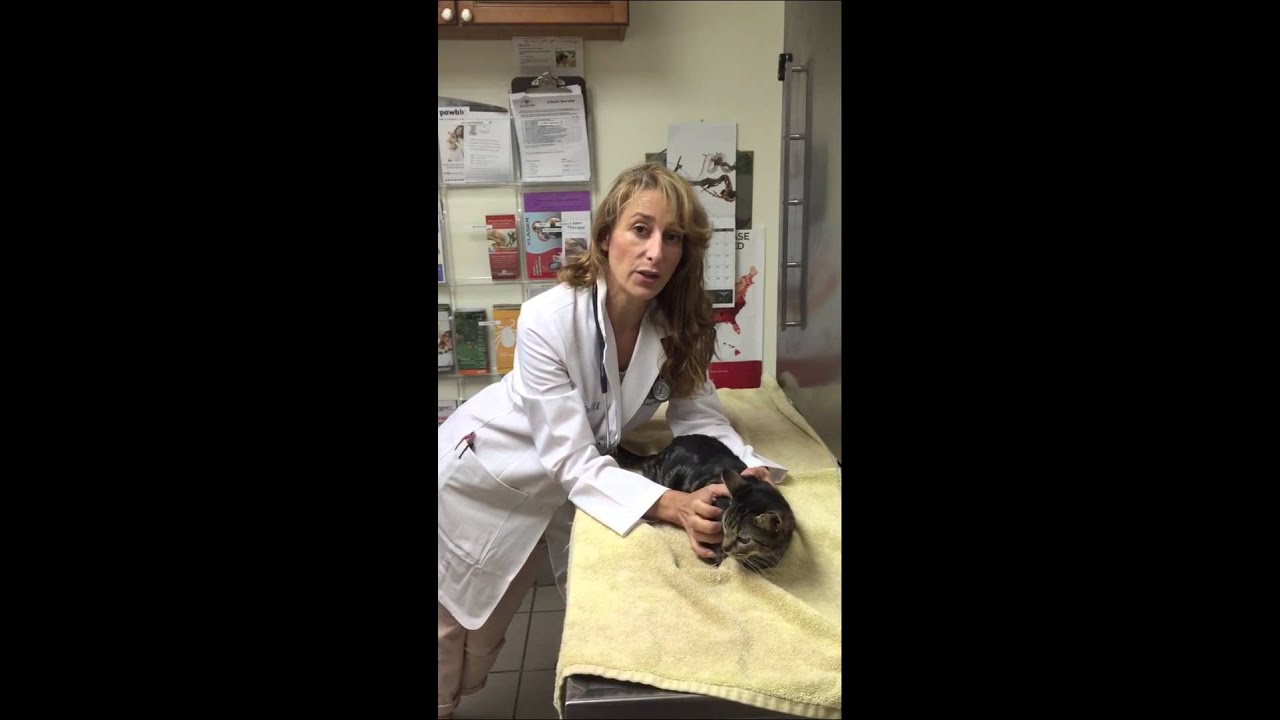

 This is also known as incomplete prolapse
This is also known as incomplete prolapse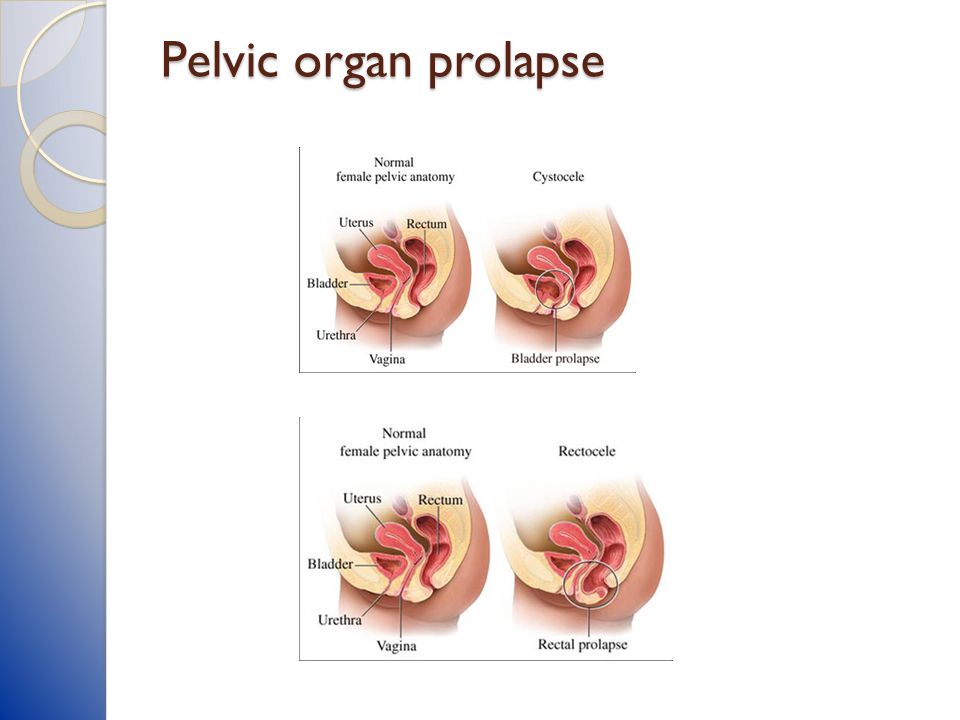
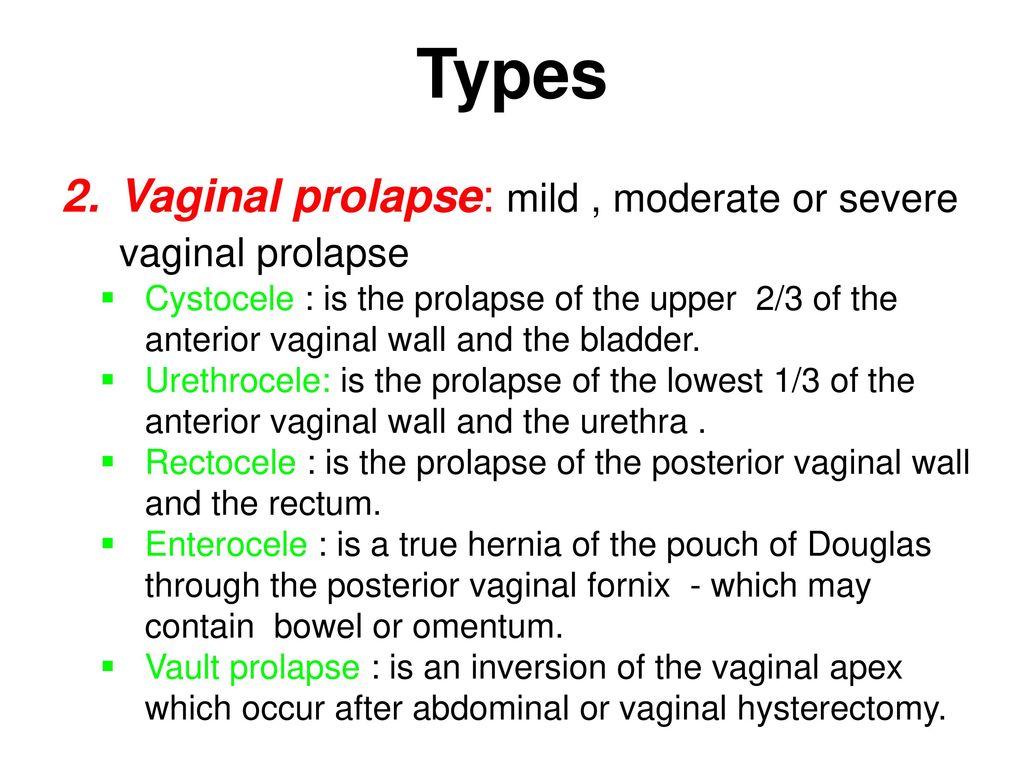 Sometimes, a short length of bowel may be removed
Sometimes, a short length of bowel may be removed


 This type of surgery can involve the inner lining of the rectum or the portion of the rectum extending out of the anus.
This type of surgery can involve the inner lining of the rectum or the portion of the rectum extending out of the anus.
